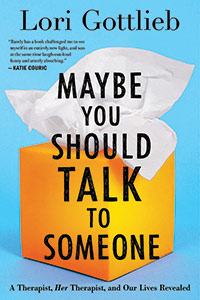Triple Booked
Based on tales from her own exercises in self-reflection, an alumna applies the art of storytelling to psychotherapy with wit and wisdom
Lori Gottlieb (MA ’10) loves a good story.
Throughout her career the journalist turned psychotherapist has shared poignant insights—most notably as the author of the Atlantic’s weekly “Dear Therapist” advice column and as a regular contributor to theNew York Times—that have been informed by her experiences in her private practice as well as in her personal life. With the release of her third critically acclaimed book,Maybe You Should Talk to Someone: A Therapist, HER Therapist, and Our Lives Revealed, an instantNew York Times bestseller, Gottlieb reveals the truth about us all: that none of us—not even those who are called upon to guide us through life’s most challenging moments—are immune from the fundamental struggles of the human condition.
 Pepperdine Magazine sat down with the Graduate School of Education and Psychology
alumna to discuss the circuitous path that led her to a career in mental health, misconceptions
about what happens in the therapy room, and her most recent book, currently being
developed for television.
Pepperdine Magazine sat down with the Graduate School of Education and Psychology
alumna to discuss the circuitous path that led her to a career in mental health, misconceptions
about what happens in the therapy room, and her most recent book, currently being
developed for television.
Pepperdine Magazine: What led you to pursue psychotherapy after working—quite successfully—in so many different fields?
Lori Gottlieb: As a young executive at NBC when the showER first aired, I was spending a lot of time in emergency rooms with real physicians. I loved the rich human stories that I was seeing, so I enrolled at Stanford Medical School because I had this fantasy of being involved in people’s life stories as their family doctor who continually guided them through the course of their lives. When I realized how difficult that would be in the era of managed care, I decided to become a journalist so that I could explore people’s stories. But when I had a baby, like many new moms, I discovered I needed to get out of the house and talk to other adults throughout the day. The UPS delivery man would come to drop off a package and I would strike up a conversation with him about diapers. One day I called the Stanford Medical School dean and said, “Maybe I should come back and finish medical school and become a psychiatrist.” She said that my interest in forming deeper and longer-term relationships with my patients seemed like a call to pursue psychology. That’s how I ended up at Pepperdine.
PM: How did you draw the connection between storytelling and providing therapy?
LG: Stories are how we make sense of our lives. Most of my work as a therapist is helping people edit their stories. I feel like I went from telling people’s stories as a journalist to helping them change their stories as a therapist. Many clients come in with faulty narratives, like “I’m unlovable” or “nothing will ever work out for me,” and I help them edit their stories so that they’re more accurate. If we’re attached to a story that’s holding us back, it’s time to reassess that story: is the protagonist going in circles or moving forward? Who are the heroes and the villains in the story, and is there another possibility?
PM: Maybe You Should Talk to Someone has achieved remarkable, widespread success. Why do you think it resonates so strongly with a broad audience?
LG: The book follows the stories of four very different patients, but I don’t tell these stories as though I’m the expert up on high. I also show my vulnerability as I go through an upheaval in my own life. I bring readers into my world as both clinician and patient.
What I want people to understand from the stories is that we’re more alike than we are different, and that we grow in connection with others. People often feel isolated in their circumstances and struggles, and either they don’t get help or they feel like they’re the only one getting help, which is just not true. Everybody is struggling with the universal condition of being human, and I want readers to see that throughout the book. I also want them to see how we get through these struggles.
PM: The stigma of seeking mental health treatment is pervasive and often delays healing in those who need it most. How does the book approach the touchy topic of therapy?
LG: My goal was to show what therapy actually is and not what some people believe it to be. Some people think that you sit in a room and talk about your childhood ad nauseam. But therapy is like holding up a mirror to your clients so they can see their reflections in a new way. By seeing their blind spots, they begin to understand what their patterns are and how they repeatedly end up in the same situations.
 Often people will say, “Isn’t it hard being a therapist—listening to people complain
all day?” But that’s not at all what we do. Who would sign up for that job if that
were the case? In reality, I’m seeing the human condition up close and getting to
know people who are grappling with important universal questions that we all come
across at some point in our lives. A lot of what happens in the therapy room is heroic,
transformative, and exciting, especially when people learn to take risks they couldn’t
take before or make choices that push them outside of their comfort zones, which completely
changes the course of their lives.
Often people will say, “Isn’t it hard being a therapist—listening to people complain
all day?” But that’s not at all what we do. Who would sign up for that job if that
were the case? In reality, I’m seeing the human condition up close and getting to
know people who are grappling with important universal questions that we all come
across at some point in our lives. A lot of what happens in the therapy room is heroic,
transformative, and exciting, especially when people learn to take risks they couldn’t
take before or make choices that push them outside of their comfort zones, which completely
changes the course of their lives.
PM: In the book you discuss the differences between “idiot compassion” and “wise compassion.” Can you describe each one?
LG: Idiot compassion is what our friends tend to offer with the intention of being supportive. We often reflexively take our friends’ sides by saying, “Yeah, your boss is a jerk!” or “You’re absolutely right and your boyfriend was wrong to do or say that!” In idiot compassion, we don’t ask our friends to consider a broader view of the situation. Wise compassion is what therapists practice with their clients. We help them to see that perhaps their interpretation of the events is not helping them grow or move forward. I like to say that we offer compassionate truth bombs.
PM: Common misconceptions about therapy include ideas that seeking help is a sign of weakness or that a person has to hit rock bottom before reaching out for professional support. What advice would you give to those who, for one reason or another, avoid therapy?
LG: You don’t have to be in crisis to go to therapy—just like you don’t have to be dying to see a doctor. I think we have this culture of overvaluing independence. We all want to have a sense of agency and feel like we can do things on our own, but the richness of life comes from connections with other people. Connecting with others is not only good for our mental health but it’s also good for our physical well-being because it lowers our heart rate and boosts our immune system.
A lot of people nowadays spend so much time staring at a screen and don’t experience simply sitting in a room with someone face-to-face, just listening and being present with nothing pinging or beeping. One thing I often say is that insight is the booby prize of therapy. In other words, you can have all the insight in the world, but if you don’t make changes out in the world, the insight is useless. I want my clients to take the insights and connect more meaningfully and more deeply with the people in their lives.
PM: How have your experiences as both a therapist and a client shaped your perspective on the other side of the proverbial couch?
LG: When clients come in for therapy, I’m listening not just to their story but also to their flexibility with their story. Are they willing to think about their own role and how that might change? Are they willing to think about the other “characters” in the story? Broadening their perspective to understand the viewpoint of others helps them to have more compassion for others and for themselves.
When you go into therapy as a therapist, you really have to take off your therapist hat and not be a backseat driver. You have to stop looking at your sessions through the lens of a therapist and be just like any other patient.
Going to therapy has made me a better therapist because it gave me a visceral sense of what my own clients were experiencing. In the book, you can see that I wasn’t any different with my therapist than my clients were with me. I would talk around certain issues or reject something my therapist said that later I came to see as spot on. I wanted my therapist to like me and I wondered what he thought of me. One night I even Googled him, found out something about his family, and avoided telling him because I was so embarrassed by what I’d done. Experiencing all of that made me appreciate even more how hard my clients were working in therapy.
PM: Eva Longoria is developingMaybe You Should Talk to Someone for television. How will the show capture the themes presented in the book?
LG: It’s important to me that we create a realistic portrait of the human condition, which means not using old clichés about therapy that aren’t accurate. So many times in the media therapists are either the brick wall—you know, the person who just nods—or the train wreck, the person who’s professionally competent but a hot mess in his or her personal life. Neither of these reflects the therapists I know. To that end, we want the show to be about a woman who works as a therapist, the people she sees, and all of their worlds—their families, relationships, careers, and struggles. Like my favorite TV shows, it’s about compelling stories of people going through the daily problems of living, but in this case, it just happens that the main character is a therapist.
This conversation has been lightly edited for clarity and brevity.
